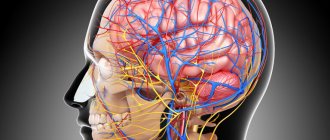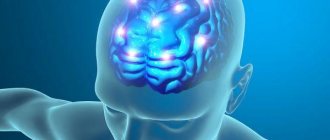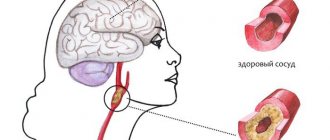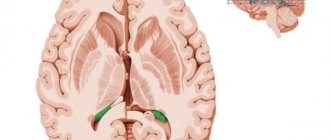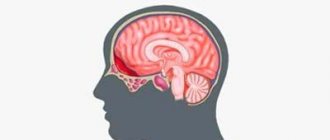Micropsia is one of the forms of distortion of visual perception of objects in the external environment and one’s own body, in which everything around seems smaller than it really is. Sometimes this disorder is called “Alice through the Looking Glass syndrome.” This disorder is not often encountered in neurological and psychiatric practice, but it can significantly limit a person’s daily activity. Moreover, he is worried not only about the micropsia itself, which can appear suddenly and disappear just as abruptly, but he is afraid of a second attack. Medical doctors will conduct a thorough examination of the patient, find out the cause of the disorder, prescribe appropriate treatment or refer you to a specialized specialist.
Micropsia: general description
The visual organ system is one of the most complex structures of our body. Although its anatomical structure has been studied in sufficient detail, the neurological and physiological mechanisms of processing information perceived by the eye are still completely unknown.
Everything we see around us is projected in the form of light rays onto the retina, the back wall of the eye. The rods and cones located in it transform them into electrical impulses, which are transmitted to the fibers of the optic nerve.
Interesting fact! The optic nerve contains about 1 million fibers, each connecting to approximately 140–150 rods and cones.
From the retina, the impulse enters the brain, or more precisely, to the visual cortex, which in humans (as, by the way, in other mammals) is located in the occipital region. Brain neurons “process” the received signals, and as a result, we perceive the surrounding reality as a holistic picture, and act in accordance with what we see.
With micropsia, a person does not perceive the real size of the objects around him. Unlike other vision pathologies (farsightedness, myopia, etc.), illusions and hallucinations are not distorted in their outlines, shape, and the general characteristics of the perceived information do not change (for example, with hallucinosis, it seems to the patient that things are coming to life, someone is in a closet, under the table, etc.).
Macro and micro - two sides of the same violation
With micropsia, the patient sees surrounding objects as exaggeratedly small, as if they were toys—much smaller than their natural size.
The second form, more rare, but complementing the clinical picture of the disease, is macropsia. With it, the opposite clinical picture is observed, when a person perceives objects, and even his own arms and legs, to be enlarged in size. During an attack, surrounding things grow right before our eyes.
Both forms of pathology are often combined and completely disorientate the patient, affecting visual perception and touch. AIWS often causes auditory and olfactory hallucinations. As a rule, this is a borderline state with the development of epilepsy and schizophrenia.
All pathological changes that the patient observes with Lilliputian vision and its opposite form do not concern the organs of vision, but occur at the mental level. affecting only cerebral analyzers. A sick psyche imposes “disfigured” sensations and visions on a person. The brain, hijacked by a neurological disorder, receives correct information from the eyes but interprets it incorrectly.
This mental state usually manifests itself in the form of an attack and often happens unexpectedly.
The patient can see a tiny table where there is a huge cup of milk, along the edge of which a giant fly is moving. Neither micropsia nor its opposite form affects the visual organs, but only the cerebral analyzers.
Micropsia: possible causes
Some experts suggest that this disorder may be caused by diseases of the organ of vision (paralysis of accommodation, retinal lesions, etc.). However, most doctors agree that micropsia is closely related to pathological changes in the visual cortex and dysfunction of the so-called detector neurons, which are “responsible” for recognizing visual impulses received from the retina.
The most common causes of micropsia include:
- epilepsy, and in children such visual distortions may be the only symptom of the disease; in adults, impaired perception is usually one of the manifestations of the aura preceding an attack;
- organic brain damage due to congenital anomalies, complications during childbirth;
- malignant tumors, benign and vascular neoplasms;
- migraine;
- previous ischemic or hemorrhagic stroke;
- severe traumatic brain injuries;
- complicated neuroinfections;
- brain surgery.
But sometimes micropsia is a consequence of various mental disorders, and the patient may not realize that his vision is distorted, and, accordingly, does not tell either his relatives or the doctor about it. Another cause of the syndrome is the use of drugs that belong to the class of hallucinogens.
How does the syndrome manifest?
Alice in the Wonderful World syndrome manifests itself in the form of sudden attacks that can last a few seconds or minutes, like a strange dream, up to several hours and even weeks when the person's mental state is under great stress.
An unpleasant property of the syndrome is that it overtakes the patient even if his eyes are closed. This is yet another additional confirmation that the disease has nothing to do with vision, but is only an unsuccessful fruit of a mental-cerebral “symbiosis.”
The attack is usually accompanied by the following unpleasant conditions:
- loss of orientation in space;
- a feeling of gaps in time, which either speeds up or slows down;
- fear, depression;
- agnosia, or the inability to recognize people and objects, although there are no impairments in the visual or auditory systems;
- impaired ability to follow a sequence of actions.
As a rule, the main symptoms are accompanied by symptoms of a panic attack:
- pressing, squeezing pain in the head;
- increased, strong heartbeat (tachycardia), pulsation in the temples;
- a sharp (over several minutes) rise in pressure;
- arrhythmic phenomena (pauses in myocardial contractions), causing an additional feeling of fear of death;
- rapid breathing, yawning and sighing, indicating hyperventilation;
- feeling of suffocation;
- trembling of the fingers, a tingling sensation in the tips up to a strong burning sensation (a consequence of the powerful release of adrenaline by the adrenal glands);
- intestinal and stomach cramps, diarrhea.
There may be other components of a panic attack, which is dangerous mainly due to a sharp “jump” in blood pressure.
Clinical picture
In neurological pathologies, micropsia is unpredictable. Only with epilepsy in a child or adult or migraine can one predict an impending attack.
In mental disorders, a similar syndrome is accompanied by a number of other specific symptoms. This:
- episodes of depersonalization and derealization: the patient sees himself as if from the outside, an image of a giant appears surrounded by familiar but small objects;
- disturbances of consciousness, when the patient has difficulty perceiving, analyzing and reacting to what is happening;
- accompanying illusions: sometimes micropsia is accompanied by visual, auditory and tactile hallucinations;
- the formation of delusional ideas, and visual impairment clearly “fits” into the structure of the delusion;
- anxiety, restlessness, fixation on certain aspects of professional or everyday life, one’s own health, episodes of panic attacks are not excluded;
- depressive state.
If the pathology is associated with damage to the central nervous system, the following are typical:
- frequent severe headaches;
- memory impairment;
- decrease in cognitive abilities, intelligence;
- seizures;
- deterioration of acuity, “loss” of certain areas from the field of view (outside episodes of micropsia).
In rare cases, a combination of neurological and mental pathologies is possible.
Medical Mystery: Alice Syndrome
There is hardly a person who has not read Lewis Carroll's fairy tale “Alice in Wonderland.” The fairy tale is a lie, but there is a hint in it. It turns out that the plot was not entirely invented by the author. Doctors are aware of diseases such as micro- or macropsia , which are also called Alice in Wonderland syndrome . This strange and rare disease is characterized by a violation of a person's perception of reality.
DON'T BELIEVE YOUR EYES
People suffering from Alice syndrome see surrounding objects and parts of their body not at all as they really are, they lose the ability to perceive their true size. In addition, there may be a violation of temporal and spatial orientation, manifested in an increase or decrease in visual images. Imagine that right before your eyes, some part of the body suddenly stretches out and changes proportions. And, surprisingly, it happens suddenly.
The same thing is happening in the world around us. A huge boulder on the road turns into a small pebble that seems easy to step over. And thanks to its new size, an elegant wristwatch can easily crush its owner. Of course, this mental disorder cannot but affect all of a person’s senses, especially vision.
In addition, time can either speed up or slow down for such people. Didn't Alice in Wonderland experience the same sensations? That is why the syndrome got its name.
For those suffering from Alice syndrome, the world around them changes overnight. For example, the floor suddenly takes on a vertical position, and the walls of the rooms close together. Chairs, tables, bedside tables and other pieces of furniture miraculously rise into the air and spin in a strange and frightening dance. The door handle turns out to be the size of a door...
However, most often it is not macro-psia, but micropsia, when objects become much smaller in size than they really are. It is not surprising that in such a situation a person completely loses control over reality.
TWISTED REALITY
In scientific terms, micropsia is a disorienting neurological condition that manifests itself in a person’s visual perception of surrounding objects proportionally reduced. Synonyms for the name of the disease are “dwarf hallucinations” or “Lilliputian vision”. However, in reality there are no problems with the eyes; changes occur only at the level of the psyche, which imposes distorted visual, auditory and even tactile sensations on the patient.
That is, the brain incorrectly perceives the information it receives from the eyes. Either the spoon becomes the size of a shovel, then the sofa turns into a doll's, then the pile of garbage on the floor becomes like a mountain. You can never predict in advance what terrible pictures the next attack will show.
The patients themselves say that during attacks of the syndrome, the feeling of stability is lost: the floor becomes wavy, but at the same time the legs get stuck in it, like in soft clay. It must be said that attacks can last from a few seconds to several weeks. Those who have visited this terrible “fairy tale” several times become alarmed, frightened and are constantly in a state of panic.
WHY?
The reason that forces a person’s brain to transfer him to a strange world of distorted reality has not yet been found out. There are only suggestions that this may be due to a hereditary predisposition to migraines.
Scientists also believe that the cause of Alice syndrome may be a complex, little-studied form of epilepsy, schizophrenia, Epstein-Barr virus (herpes) and mononucleosis. This condition can also be observed with malignant brain tumors or brain damage in the parietal region.
As a rule, micropsia is characteristic of children aged 3 to 13 years. The older the child becomes, the less frequent the attacks, and by the age of 25-30 the symptoms disappear completely.
THROUGH THE EYES OF AN EYEWITNESS
One of those who were “lucky enough” to find themselves in Through the Looking Glass, Rick Hemsley, talks about his illness like this:
“When this first happened, I was a 21-year-old student. The day before I didn’t sleep for a long time, drank a lot of coffee and wrote a coursework, but I felt fine. And then I stood up, bent over the remote control, and my legs seemed to sink to the floor. Looking down, I saw that my foot was buried in the carpet - an unpleasant feeling, but it only lasted a few seconds.
I soon discovered that I had more serious spatial disturbances. The floor beneath me either undulated or sagged, and when I tried to walk, it felt like I was hobbling on sponges.
If I lay on the bed and looked at my hands, my fingers would stretch out half a mile forward. These strange experiences began to happen more and more often, but I did not pay attention to them, believing that it was due to stress, poor sleep or eating habits.
I graduated and got a job as a system administrator, but instead of going away, my symptoms got worse. Now everything was distorted, and constantly. When I walked along the road, the cars standing on the side of the road looked like toys, and I seemed disproportionately tall.
At work, my chair looked huge, and I felt like I was squeezing myself into it.
Soon, going outside began to require a lot of effort: I could hardly understand what surface I was walking on, so walking was difficult. Crossing the road became dangerous: I had no idea how big the approaching car was or how far away it was from me.
Since I was no longer able to work, I moved in with my parents. I learned about Alice in Wonderland syndrome from a TV show. I began to hope for a cure, but neither my therapist nor the neurologist could find a description of this disease. They said I had to learn to live with it.
I'm 36 now, and fortunately, I now only experience spatial distortions once a month. I still haven’t figured out the reasons for my condition, but now I can lead a relatively normal life. There are certainly endless complications associated with this syndrome, but there are some things I actually like about it: sometimes, especially after I wake up, I have a special binocular vision.
Lying on the bed, I look out the window at the crows, 100 meters away from me, circling above the trees, but at the same time I see every bird and every tree top in detail, as if they were at arm's length. This side effect seems to be gradually disappearing and I hardly miss it anymore.”
THE STORY OF JOHN D.
John D., a 30-year-old employee of the American aircraft manufacturing corporation, had “changes” on the right side of his head. It seemed to him that she had swelled up like a huge growth. Squinting his eyes to the side, he saw its gigantic hemisphere rising about a meter up.
“I had to reach as hard as I could to feel my right ear, and my arm was still barely long enough,” John recalled. The doors became a big problem.
Despite. that John was well aware that in fact his head was of normal size, he had to take various precautions, since several times he had already hit his head hard on the doorframe - his orientation in space clearly left much to be desired.
The head was not always in this state - the right half either shrank to its normal size or swelled. It took doctors several months to find the right combination of medications, with the help of which John said goodbye to the magic syndrome.
RETURN TO REALITY
The first person to recognize reality distortion as a disease was Dr. Lippman. He wrote about this in 1952 in the Journal of Mental Diseases in his article “Hallucinations Associated with Migraine.” He was the first to connect the syndrome with Alice’s feelings. There is a suspicion that the author of the popular fairy tale, Lewis Carroll himself, suffered from attacks of micropsia and knew very well the world in which his heroine wandered. However, these are just assumptions. A more accurate description of the symptoms and causes of the syndrome was made in 1955 by the Canadian doctor John Todd.
There is a disease, which means there must be ways, if not to cure the patient, then at least to alleviate his suffering. The first thing to do when symptoms occur is to consult a doctor, who will identify the cause of the condition and, depending on this, prescribe treatment. Most often, the same drugs are prescribed as for migraine.
For many this is enough. Otherwise, as with any other disease, it is recommended to follow a daily routine, sleep, nutrition and drinking regimen. And of course, loved ones should always be on alert and provide help and support to the patient during attacks.
As a rule, children are not too frightened by this condition; they perceive it as a fabulous journey, which cannot be said about adults. It is very important to give up activities such as rock climbing, swimming in open water, driving a car, as the disease in this case can cost your life.
The main thing is to remember that science does not stand still, and hope that perhaps soon the syndrome will be treated. The sick will return to the real world, just as Carroll’s heroine returned.
Alexandra ORLOVA
Cost of services
| CONSULTATIONS OF SPECIALISTS | |
| Initial consultation with a psychiatrist (60 min.) | 6,000 rub. |
| Repeated consultation | 5,000 rub. |
| Consultation with a psychiatrist-narcologist (60 min.) | 5,000 rub. |
| Consultation with a psychologist | 3,500 rub. |
| Consultation with Gromova E.V. (50 minutes) | 12,000 rub. |
| PSYCHOTHERAPY | |
| Psychotherapy (session) | 7,000 rub. |
| Psychotherapy (5 sessions) | 30,000 rub. |
| Psychotherapy (10 sessions) | 60,000 rub. |
| Group psychotherapy (3-7 people) | 3,500 rub. |
| Psychotherapy session with E.V. Gromova (50 minutes) | 12,000 rub. |
| TREATMENT IN A HOSPITAL | |
| Ward for 4 persons | 10,000 rub./day |
| Ward for 3 persons | 13,000 rub./day |
| Ward 1 bed VIP | 23,000 rub./day |
| Individual post | 5,000 rub. |
| PETE | 15,000 rub./day |
This list does not contain all prices for services provided by our clinic. The full price list can be found on the “Prices” , or by calling: 8(969)060-93-93. Initial consultation is FREE!
Prevention
Yoga classes will help you cope with emotions during attacks and teach you how to control yourself
There are no specific ways to prevent Alice in Wonderland syndrome. As a rule, for this purpose, recommendations that are general for the prevention of all such conditions are used.
To prevent micropsia (macropsia) from appearing, you must:
- cultivate resistance to stress;
- have a full rest, walk in the fresh air, lead an active lifestyle - this will strengthen both physical and mental health;
- do yoga, meditate - this will help relieve stress, relax, and strengthen the nervous system;
- Eat right – your diet should not contain foods that can trigger migraine attacks.
Yoga classes will help you cope with emotions during attacks and teach you how to control yourself
Preventive measures
As in most cases, preventive measures involve:
- adherence to daily routine;
- compliance with the drinking regime;
- maximum reduction of exposure to external irritants and stress factors on the body;
- normalization of sleep and achieving its duration of 8 hours;
- minimizing in the diet foods that provoke migraine attacks - citrus fruits, cheese, alcohol, caffeine, chocolate.
Often, children react more loyally to the manifestations of the syndrome in question than adults, since they are the first to think that they are on a fairy-tale journey.
Adults are strongly advised to avoid driving, swimming in open water, rock climbing and other potentially dangerous activities if they have seizures, otherwise the outcome could even be fatal.
Related posts:
- Is it possible to quickly cure phobias? A phobia is a neurosis that manifests itself in the form of a strong, difficult...
- Causes of acute stress Acute stress is the most common - it occurs in connection with an immediate threat or...
- Emotional stress Stress is a human condition that occurs in response to a variety of...
- Constant lies. Mental illness or character trait? Pathological lying or pseudology is a pathological tendency to tell a false...
Useful video
https://www.youtube.com/watch?v=cScKqRgqPYM
Micropsia is a fairly rare disease that affects pediatric patients. The disease is accompanied by additional pathologies. They can provoke the development of pathology in a child.
Author's rating
Author of the article
Alexandrova O.M.
Articles written
2100
about the author
Was the article helpful?
Rate the material on a five-point scale!
( 1 ratings, average: 4.00 out of 5)
If you have any questions or want to share your opinion or experience, write a comment below.
Symptoms
Micropsia occurs with symptoms that only affect the perception of the picture. The characteristic signs of the disease are:
- disorientation in space;
- distortion of the dimensional characteristics of objects;
- stationary objects can be characterized by movement;
- loss of sense of time;
- causeless fear;
- inability to recognize faces;
- intense pain in the head area;
- tachycardia;
- significant increase in pressure;
- arrhythmia;
- tremor of the limbs;
- chest compression;
- disorders in the gastrointestinal tract.
In the presence of pathology, there is difficulty in perceiving the surrounding world. The patient cannot care for himself.
There are known cases of spontaneous disappearance of signs of the disease.
Diagnostic methods
What should a person diagnosed with Alice in Wonderland syndrome do? Treatment, of course, exists, but, unfortunately, there are no drugs that can completely stop attacks. To begin with, doctors recommend undergoing a full diagnosis. If it is possible to determine the causes of disturbances in spatial perception and eliminate them, then there is a good chance that the seizures will disappear altogether (for example, patients are prescribed drugs for epilepsy, antipsychotics, and in the presence of a brain tumor, chemotherapy or surgery is performed).
Treatment tactics in most cases depend on the etiology of megalopsia. The main task of the doctor is to discover the causes of the disorder and eliminate them. In case of intoxication, detoxification therapy is also indicated; accommodation spasm is relieved with the help of mydriatics, special exercises, and massage. Mental disorders should be eliminated together with a psychiatrist.
Now you know what macropsia is. We hope this information was useful and interesting.
September 20, 201511034
January 27, 201720591
December 17, 20177650
Are there any physiological changes?
Of course, over the past decades, many studies have been conducted to explain the occurrence of such attacks. During testing, it was found that due to the disease there were no changes in the anatomy or physiology of the eyes, including the retina.
Thus, it was assumed that the human eyes work normally, transmitting the resulting images to the visual centers of the brain. The problem for a patient diagnosed with Alice in Wonderland syndrome is that the brain stops correctly interpreting the information it receives through the organs of vision.
Diagnostic measures
Alice syndrome is diagnosed based on data obtained during an anamnestic conversation. These may be complaints and sensations of the patient himself or loved ones observing him during an attack.
To identify the cause of micropsia in a particular patient, the following is also carried out:
- electroencephalogram;
- CT scan;
- spinal puncture with examination of cerebrospinal fluid.
If necessary, a narrow-profile examination of the patient is carried out and other types of studies are prescribed to determine the general condition and identify concomitant diseases.

